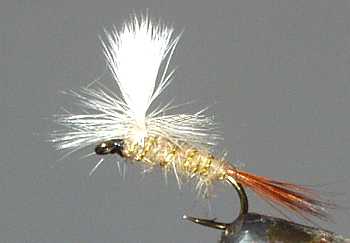The Gold Ribbed Hare's Ear Parachute Dry Fly
The Gold Ribbed Hare's Ear Parachute Dry Fly is the fishing fly pattern to use during a hatch of mayfly. This GRHE para emerger is taken by trout looking for insects emerging on the surface. The white post hair helps with visibility

PARACHUTE EMERGER DRY FLIES. Hook size 12 14 16 18 20 24 - $US each
The Gold Ribbed Hare's Ear is one of the all time great effective classic patterns. It is a "must have" fly in everyone's fly box. It is not an imitation of a particular insect but a general representation pattern that takes fish again and again and again. This is classified as a "Fancy" pattern. I would not be without it. Years of experimenting have resulted in the general rule that a shaggy, scruffy hairy nymph is better at catching trout near the surface than a slim sleek nymph.
Parachute dry flies have had their devotees for decades. There have been many articles in fly fishing magazines that praise the way they descend gently to the water surface, light as a feather and instantly fool a waiting trout. Some anglers dismiss them as not proper dry flies. To them a dry fly mimics the natural hatched mayfly dun waiting for its wings to dry on the surface film by standing erect on the surface film on the end of its cock-hackle points, and not floating in the surface film like a parachute dry fly.
I find parachute dry flies like the Gold Ribbed Hare's Ear float better than normal dry flies because they present their hackle fibres sideways to the water, a much larger surface contact than is possible with the conventional cock hackle points of the standard dry fly pattern. Parachutes cannot look the same to the fish, their silhouette is different, but they certainly catch trout.
I believe the trout mistake a GRHE parachute dry fly for a real hatching dun or a cripple that is stuck and cannot release itself from the nymphal case, rather than a hatched dun drying its wings. I normally cast a parachute upstream of a suspected feeding zone and let it drift with the current. I find an occasional twitch of the line that imitates the insects struggle to emerge into a dun, works to stimulate a take.
CUSTOMER'S COMMENT
would say yes the para emergers work very well in the tri state area they produce fish when others will not. I have fish all of my emergers in New York , PA, CT and New Jersey I must say they out perform day in and day out most other dry fly patterns. Don't do a lot of nymphing but when I do it's bead head gold ribbed hares ear with a midge dropper. Allen Landheer USA
Fly Fishing books

